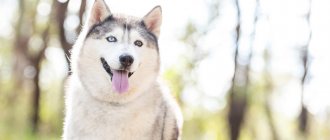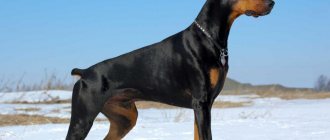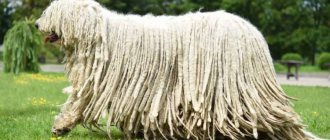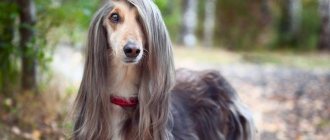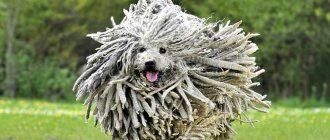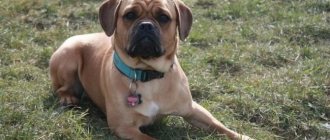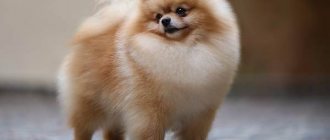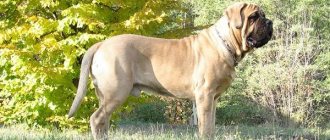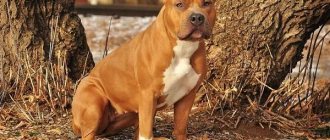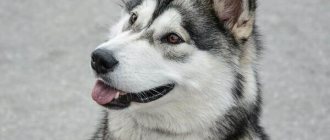Four-legged friends have served man for many millennia. Each breed has its own purpose. Since ancient times, northern sled dogs have been used in the Arctic Circle to transport people and goods over long distances. During this time, among them there was a selection of representatives with a characteristic appearance and specific qualities, thanks to which they are able to cope with their task better than others. With the participation of these hardy, intelligent animals, both poles of the Earth were conquered, Alaska was developed, and the northern regions were explored.
Sled dogs are the fastest animals in the world over long distances. In addition to physical endurance, they are distinguished by their balanced character and willingness to protect the owner from the bear and help in the hunt. Modern sled dogs successfully participate in sports competitions - cross-country racing in a sled with a load. At the world championship the distance is more than 100 km. The most common breeds are huskies, huskies, and malamutes.
Northern Inuit dog
The breed, which is not recognized by the Fédération Cynologique Internationale but has its own amateur club, was developed in the 1980s in Canada as a result of crossing several breeds: Siberian Husky, Alaskan Malamute, Eskimo dog and German Shepherd. Genetic studies have disproved the presence of wolf genes. Proper upbringing and training of puppies that resemble a domestic wolf is necessary from early childhood: dogs are difficult to train. But they can be loyal and devoted friends, smart and friendly, unpretentious and hardy. Specially trained Inuit dogs are recruited to serve in the police - to search for drugs, save people, and act as guides.
Anatolian Shepherd
This is a serious rock breed, the representatives of which are harsh, hardy, agile and capable of covering long distances. Used in Turkey over 6,000 years ago to guard herds, the Anatolian Shepherd has low energy levels but strong protective qualities. From an early age, she needs to understand who is in charge in the house, and the owner needs to introduce the serious guard to new guests.
Tamaskan dog
This breed was bred in Finland on the basis of huskies, Alaskan malamutes, Siberian huskies and German shepherds exported from the USA. The wolf-like dog is not officially recognized by the FCI. Dog breeders from all continents have become interested in it. The elegant and picturesque-looking dog has highly developed mental abilities and excellent working qualities, and demonstrates high results in sports competitions. Animals do not tolerate loneliness well and do not like to be left at home alone. Aggressive behavior is not typical for Tamaskans, but if they suspect a threat, the dog’s actions will be unpredictable. Among his relatives, the dog prefers to be a leader. He allows himself to be stroked only by those who are especially trusted.
German Shepherd
The breed gained its popularity after the appearance on screens of Rin Tin Tin, a stray German shepherd puppy found during the First World War and becoming a character in television shows and films.
Representatives of the breed are excellent shepherds, security guards and police officers. They are strong, agile, hardworking, energetic and learn new things quickly.
German Shepherds are prone to hip dysplasia; To avoid these health problems, you should purchase a purebred animal only from trusted breeders.
Canadian Eskimo dog
The oldest North American Eskimo husky (otherwise known as the Inuit dog) is a Spitz dog. It is considered the rarest surviving purebred native breed. More than a thousand years ago they were moved from Siberia to the American continent. Now a few representatives of Canadians are on the verge of extinction. Dog lovers have created a special fund for its restoration and are working to increase the number of animals. In the 80s, the breed was recognized by the Canadian Kennel Club.
With its strong build and impressive appearance, the Canadian dog resembles a wolf. Her physique proves the animal's ability to do hard work. Their thick, warm coat allows them to withstand very low ambient temperatures. Representatives of the breed are distinguished by intelligence, courage, devotion, and hard work. They can stay in the cold for days and get their own food. Now they are used for tourism and commercial polar bear hunting.
Chinook
The breed was developed at the beginning of the twentieth century. American dog handler, who named her after one of the first representatives. In the selection process, the goal was to select working qualities: speed of movement, adaptation to low temperatures, endurance, athletic build, high intelligence, devotion. They have an unremarkable appearance, but to obtain certain properties of the breed, which is not yet officially recognized, breeders had to make great efforts. In the middle of the last century, Chinooks were at risk of disappearing; their preservation was ensured by the creation of the Association of Fanciers, whose members consider these dogs a national treasure and seek official recognition of the breed. In 2009, the Chinook was declared the state symbol of New Hampshire.
Read Top 20 best guard dogs for protecting a private home
Kugsha
- Height: from 51 to 69 cm
- Weight: from 27 to 50 kg
- Life expectancy: 12 to 14 years
- Temperament: smart, resilient, curious, playful, stubborn
No official kennel club recognizes the kugsha, so such a pet can be difficult to find. This is a large dog with a wolfish appearance and high intelligence. Most experts recommend this breed only to experienced owners because the kugsha is difficult to train. On the other hand, the Kugshu is moderately sociable, creates a strong bond with family members, and can make an excellent pet for an active owner.
Kamchatka sledding
The specificity of the breed is that it was created by nature itself, without human intervention, several thousand years ago. This fact is confirmed by archaeological excavations. Now this aboriginal breed, the standard of which was developed and adopted in our country in 1992, is on the verge of extinction. Enthusiastic dog breeders are trying to revive it in special nurseries using their descendants - Alaskan huskies.
Laikas, exemplary for the conditions of Kamchatka, are very loyal, smart and resourceful in difficult situations. There are many cases where dogs rescued their owner in a snowstorm, digging out the sled and delivering it home. They are patient, balanced and hardworking, obedient and ready to carry out the instructions of the owner.
Shiba Inu
The Shiba Inu has a thick, two-layer coat. This dog is energetic, talkative and always ready to explore.
“Goku loves snow,” the owner of a 2.5-year-old dog says about his pet. - I call it playfulness - he can frolic all day long. “I have a lot of videos of Goku bathing in the snow, and he also likes to look for things in the snowdrifts.”
Chukotka sledding
The indigenous breed, bred by the peoples of the Far North and East of Russia, is not recognized by the FCI. Isolated keeping in the populated areas of Chukotka made it possible to preserve the breed's gene pool. Dogs differ advantageously from other sled breeds in their economical type of protein and fat metabolism, extreme strength, hardening, and ability to work. They help people in many types of work; they prefer to do useful things than relax.
Dogs are still used for their intended purpose - to transport luggage, although they have long shown serious promise for use in sports races over long and ultra-long distances. Their advantage is their excellent sense of smell, which allows them to find their way in any extreme situations. Representatives of the breed have an independent character, restraint, and friendliness towards people.
Tibetan mastiff
For some time, Tibetan mastiffs existed exclusively in the Himalayas.
Tibetan Mastiffs feel comfortable in both low and high temperatures. Thick and long two-layer coat protects them from the effects of adverse weather conditions, while in winter the dogs' undercoat is thick and heavy, and by summer it decreases.
Representatives of the breed are predominantly black or brown in color, but there are also red Tibetan mastiffs, which are considered the most expensive (one puppy is estimated at $1.5 million).
Not long ago, a curious incident occurred in a Chinese zoo when they tried to pass off a Tibetan mastiff as an African lion; the spectators were extremely unhappy when they heard the barking of a supposedly representative of the cat family.
Alaskan Husky
Tough, hardened, and adapted to the harsh conditions of the north, Alaskan Huskies combine the best properties from each of several breeds. These are the most valuable mestizos in the world. Genetic studies have shown that they are closest to Siberian Huskies and Alaskan Malamutes, although development has been disordered for many thousands of years. The dogs are not recognized by the Fédération Cynologique Internationale, but enthusiastic breeders are working to preserve the breed’s qualities and include them in the official register.
The Alaskan Husky is a dynamic, intelligent dog with an independent character and comes in all colors. Now she is bred to participate in sled racing. Speed is inherent in them by nature. With proper training, she can become a good companion for energetic private home owners.
Care, maintenance and education
Very often sled dogs have to be given away to shelters because the owners cannot cope with their upbringing. As a rule, the reason lies in the fact that some potential owners poorly understand that such dogs are simply not adapted to the apartment-sofa lifestyle. Excessively little activity will certainly result in health problems and behavioral disorders for your pet, and pieces of home furniture will certainly be subject to “vandalism” by the dog.
Preparing the dog
The easiest way is to immediately orient the dog to participate in sledding sports events. Such training should begin from a very early age, around 4-6 months. It is preferable, of course, to contact a specialist who will help you create a training schedule and give the necessary recommendations for education.
To achieve any success in the sports field, you need to achieve complete obedience from your pet. To do this, he needs to undergo a standard training course (about a year) in order to learn classical commands. Then you can start riding lessons. It is worth noting that some breeds of northern dogs are not very trainable, therefore, professionals advise every owner to stock up on a fair amount of patience. This feature is associated with some excessive independence of the sled breed and general complacency, because initially they were accustomed to obeying their leader in the harness, and not the owner.
At the same time, you should not completely destroy the dog’s innate skills of working in a team, then you can simply end up with an individual farmer who is not able to work in a team. Usually, the first commands are “Come to me!”, “Sit!” and “You can’t!” These are the so-called elementary orders that any dog must follow. Further training is based on instilling special commands - for sled dogs these are, as a rule, “Left”, “Right”, “Stop” and “Forward”. At the same time, all individuals in the harness must act as a single mechanism, i.e. understand any command equally.
When special orders have been learned, you can move on to developing correct behavior - dogs should not fight among themselves or be distracted by extraneous stimuli while working. Still, it’s worth recalling once again that keeping a sled dog breed in a city apartment is not the best idea. Many breeds, at the level of genetic memory, need not only constant running, but also experience the need for regular work - the need to drag any load. In an apartment, televisions, pillows, and other large household items become such “cargo.” Thus, the key to the best training for a sled dog is to provide it with sufficient exercise right from a young age.
Ammunition used
For the dog to feel comfortable when participating in competitions, he needs to choose the right equipment. The main element is a special riding harness, the design of which allows you to equally distribute all the resulting load throughout the animal’s body. It is preferable that the harness be made of durable and high-quality materials that do not rub the pet’s fur and skin, and its dimensions can be easily adjusted to suit the dog’s height. An additional necessity will also be a shock absorber, which is a belt through which the owner communicates with the dog. It is attached on one side to the owner's belt, and on the other side to the dog's harness. Such a shock absorber is designed to soften the pet’s sudden jerks, preventing excessive impact on the human spine.
Historical and selection features of sled breeds
Sled dogs are very curious animals, the history of use and breeding of which goes back more than 8 thousand years:
- Their use made it possible to “overwrite” many “blank spots” on world maps - for example, the first conquerors of the poles got to their destination on sledding vehicles.
- Dogs of this type can, on average, cover about 80 kilometers per knock as part of a team. At the same time, the driver must ensure that the animals do not become overtired, which is why it is necessary to maintain a constant speed of no more than 12 kilometers per hour.
- When using sled dogs, it is necessary to evenly distribute the load for each individual. Usually, experienced dogs, accustomed to acting in a group and recognizing a single leader, do not try to “cheat” because they can be punished by the “alpha” at the next rest stop.
- It is worth noting that, unlike any other draft force (for example, horses), physical “tips” in the form of a whip, reins are almost not used for dogs - their training is structured in such a way that they carry out only verbal commands. However, some mushers (mushers) can use a long pole to more successfully guide a long team.
- Dog handlers have long noted that sled breeds have a pronounced socialization towards humans - for a job well done, the dog should be thanked not only with a tasty treat, but also with obvious verbal or physical gratitude, be it kind words or a simple stroke. At every stop, professional mushers will definitely approach each dog and show it signs of attention. At the same time, if the owner has a separate pet that gets the most attention, then his relatives will definitely give him a “thrashing”.
Seppala Siberian sled dog
The breed was developed by the Norwegian Leonard Seppala, a passionate fan of sled dog racing, based on sled dogs brought from northeast Asia to Alaska. This happened at the beginning of the twentieth century. He achieved unique results in his activities and earned fame among professionals. In 1925, he promptly delivered anti-diphtheria serum using dogs more than 500 km in a snowstorm and thereby saved thousands of people. Until 1997, the Seppala dog and the Siberian Husky were officially considered one breed, and only recently they were separated.
The Seppala sled dog is distinguished by loyalty, stamina, and perseverance. Thanks to her friendly, good-natured character, she becomes attached to her owner and does not like loneliness. Well amenable to training.
Mackenzie River Husky
Mackenzie River Huskies are relatives of several varieties of aboriginal sled malamutes that lived on the banks of this river. The breed was almost lost in the first half of the twentieth century; now it is being restored in North American nurseries. She received no official recognition. Large, strong dogs that tolerate cold well are capable of transporting cargo sleds in northern conditions. They are successfully trained for police and rescue services.
The dogs are distinguished by their lean build, well-developed muscles, and strong limbs. The coat color is traditional - black, gray, white, brown. Dogs are characterized by high intelligence, activity, trustfulness and a friendly attitude towards humans. They are easy to train.
Read Top 20 smallest dogs - small breeds
Sakhalin Husky
Among sled dogs, Sakhalin Huskies are the largest. They have impressive paws and thick fur. Now the oldest aboriginal working breed (Nivkh dog) is on the verge of extinction. It is otherwise called the Sakhalin Laika, Gilyak Laika, Karafuto-Ken (in Japanese - Sakhalin dog). Most versions of the origin of the breed call Japan the birthplace of the animal. Now they are intensively trying to restore the breed.
Sakhalin residents devotedly helped people hunt bears and hunt for seals, but their main purpose was driving over rough terrain. Smart, loyal dogs are distinguished by courage, endurance, unpretentiousness and an unflappable character. In the first half of the twentieth century, the sled dog was used for the needs of the Red Army.
Lapinporokoira
Lapinporokoira or Lapp Reindeer Dog appeared artificially after the selection of aboriginal hunting dogs of the north. After the ancient tribes began to breed large animals, the reindeer herding dog began to be used for herding and sledding. For some time the breed was on the verge of extinction. Externally, it is of medium size, muscular paws, and thick black fur.
Alaskan Malamute
The breed was bred in ancient times by the Eskimos of the Malemute tribe. They transported goods and people in the North, helped guard the camp and hunt. There is an assumption that they originate from domesticated wolves, which is confirmed by recent genetic studies and archaeological finds. The breed became widespread during the Klondike Gold Rush. Now the Alaskan Malamute is the official symbol of Alaska.
Dogs have persistence, intelligence, friendliness, and leadership qualities. Despite their impressive appearance, they are not suitable for guard duty due to their lack of aggression towards humans. He is difficult to train and gets along well with other dogs.
Akita
The Akita is truly a royal dog from Japan, where previously only members of the imperial family could own it. Akita statues were given as gifts for the birth of a child. They were believed to bring health, happiness and long life.
Representatives of the breed, originally bred for hunting in harsh weather conditions, have a thick undercoat and a hard top coat. Their hallmarks are independence and stubbornness, but at the same time, pets are loyal to their family and strive to protect its members.
Taimyr sled
The formidable-looking dog is a real northern wolfhound. The indigenous breed of sled dogs of the peoples of the Far North was included in the State List of breeding achievements approved for use since 1993. A French traveler purchased several animals in the village of Volochanka from local residents and took them out of Russia. The dog received European recognition and participated in exhibitions in France. Now volunteers in Taimyr are trying to restore the breed of individuals exterminated by vagabonds.
Instead of an epilogue
Sled dogs have always been characterized by an increased level of conditioning, activity, strength and endurance, which indicates a particular degree of popularity among professional dog breeders. In addition to their aesthetic function, they will perfectly cope with the role of a companion and friend for their owner. Articles can also be a family pet, but we must not forget that these are primarily service dogs, designed to perform certain work for the owner. Today, the world knows about two dozen of the most common breeds of northern dogs, but not all of them can cope with the driving function.
Norwegian sporting mix
Norwegian sled dogs were bred in the 80s of the twentieth century specifically to participate in competitions by crossing the shorthaired pointer, greyhound and pointer. From each breed, the dog took their best qualities: size, speed, endurance. Nowadays, dog athletes are specially adapted to the distance: after the first year, they are divided into sprinters, stayers and middle-distance runners. Trained teams can reach speeds of up to 60 km/h.
Dogs are unpretentious and can spend a lot of time outdoors in winter. Norwegian mixed breeds do not need to be walked; they only need training to expend energy.
Note to readers
In 2006, a special sled dog nursery “Severny” was organized in a picturesque forest area near Moscow. The purpose of its creation is the breeding and preparation of animals for participation in international and Russian competitions. At the same time, tourism is developed in the nursery. Sledding rides are carried out in winter in classic sleds, and in summer the animals are harnessed to a quad bike. In the Severny nursery you can get acquainted with fifty representatives of breeds, from the most popular to the rarest, aboriginal mestizos.
Greenlandshund
The Greenlandshund resembles a husky. This ancient breed is classified as a Spitz in the Fédération Cynologique Internationale classification. It is larger than Siberian Huskies, but smaller than Alaskan Malamutes. At home, she transported cargo and helped hunt polar bears, seals and fur seals. Dogs took part in many northern journeys, especially in the expeditions of the polar explorer F. Nansen. They withstand harsh living conditions thanks to their two-layer fluffy wool.
Over the course of many centuries, dogs have retained and developed excellent working qualities: reliability, strength, endurance, excellent intuition and sense of smell, and unmistakable orientation. They prefer to live and work in a pack. If the authority of the owner is indisputable, then the husky will protect him and show devotion. Despite their strong-willed nature, Greenlandshunds are balanced, cold-blooded and friendly.
Swedish Lapphund (Lapland Spitz)
The Swedish Lapphund or Lapland Spitz was bred in the vastness of Lapland for grazing and corralling livestock, and is now used as a companion or decorative dog. Externally, it has a small size, massive paws, thick and shiny fur, and black color. Can be used as a guard, but with proper training.
It is interesting that most northern dog breeds have a kind, easy-going character, despite the fact that they are used for protection and protection. Such qualities as aggression, anger and complete independence are not inherent in them.
Greenland sled
Dogs of this rare breed, whose homeland is Denmark, have long served people faithfully. They are classified as Spitz dogs. They are freedom-loving, make their own decisions, and follow the owner’s commands if they do not contradict their attitude. Greenlanders are valued for their beauty, powerful build, developed muscles, and strong limbs. They are smart, freedom-loving, independent, do their work conscientiously, and are in good health. These are real hard workers: they serve in the police, herd herds, and work as guides. They simply need to be trained regularly; it is not advisable to keep them in an apartment or enclosure.
Greyster
- Height: from 56 to 70 cm
- Weight: from 27 to 36 kg
- Life expectancy: 10 to 15 years
- Temperament: calm, active, friendly
The Greyster is another extremely rare breed of dog that is closely related to the Greyhound and shares many similarities in appearance and temperament with Greyhounds. These athletic dogs tend to be very calm and rarely become aggressive. They have enough energy for sledding, but they also enjoy lounging around with the family, lying on the couch together and watching TV.
Siberian Husky
The homeland of this breed is Eastern Siberia, but the dog bred by the Chukchi was almost exterminated in Soviet times. It was preserved and restored by American dog handlers. In 1934 it was officially registered. Among sled dogs, the Siberian Husky is considered the fastest and most tireless. An intelligent, independent animal is distinguished by cleanliness, activity, friendliness, and optimism. They are easy to train and do not show aggression, so they are suitable as a companion for families with children. Purebred representatives are conventionally divided into working, sports and exhibition. In addition to sled racing, four-legged workers are now successfully used for extreme tourism and recreational riding.
Read The strongest dogs in the world - top 20 powerful breeds
Kuvasz
According to the requirements of the American Kennel Club, Kuvasz must have only white color. This dog’s homeland is Tibet, and the name is translated from Turkish as “armed guard of the nobility.” In the past it was owned by members of the Hungarian royal family. Later, representatives of the breed became common as hunters and shepherds.
The Kuvasz's double-layer coat makes them excellent mountain dogs, and their quick learning, fearlessness and strong protective instincts make them an ideal furry companion.
Energetic and potentially destructive, kuvaszs require space, such as a fenced-in yard.
Yakut Laika
An ancient aboriginal breed bred in the 17th century in the Nizhnekolymsk region of Yakutia. It existed under different names, mostly related to the names of the surrounding rivers in which dog food was stored. Laikas carried luggage, helped hunt, and participated in northern expeditions. For a long time, the dog was under threat of extinction, only at the end of the twentieth century. It was possible to restore it and approve the breed standard, receiving official recognition from the RKF. Now representatives of the breed can participate in exhibitions and sporting competitions.
The dogs are distinguished by their muscular, compact build and fluffy coat. They are fearless, active, sociable, intelligent, peaceful and absolutely non-aggressive, but they will not tolerate undeserved insult even from the owner.
Newfoundland
These wonderful family dogs have low energy levels, but are full of friendliness and caring. Fluffy giants, whose weight can reach 68 kg, are calm and patient.
“Newfoundlands’ thick coats protect them from the icy waters they were originally bred to work in,” DiNardo explains. These Canadian dogs are still used today during water rescue operations; Having a two-layer “fur coat” and a strong body, they also feel great in the mountains.
Newfoundlands have a good quality - they almost never bark. However, future owners of a furry giant should take into account that this pet has profuse salivation.
American Indian dog
Representatives of the aboriginal breed resemble shepherds in appearance. Their homeland is America. Among the Indian tribes, these dogs were a significant component of their civilization. In the old days, these working dogs performed various functions: they guarded herds and camps, helped in hunting, warmed people, and transported luggage. They do not need too much physical activity. They are unpretentious in terms of living conditions and food, smart, friendly, easily adaptable, devoted to the owner and his family, understand them perfectly, and are ready to protect them.
The almost extinct breed, not officially recognized, is now beginning to recover thanks to enthusiasts.
Chow chow
These dogs are best known for their black tongues and "wool coat" that makes them extremely resistant to the cold. “If you like to be outside and own a Chow Chow, by all means take him where there is snow,” says Pat Foose, a breeder of the breed in Colorado. “These animals are extremely happy to spend time with their loved ones.”
Samoyed husky
Samoyeds are one of the most ancient varieties, bred in ancient times by the nomadic tribes of the tundra. This native breed, classified as a purebred Spitz, is believed to be descended from Nenets Laikas. In addition to the international standard, 6 national breed standards are now registered. Externally, Samoyed huskies resemble polar bear cubs due to their double thick fluffy fur. They are elegant and charming due to the structure of the muzzle and the expression of the eyes, which is called the “Samoyed smile”.
Dogs know how to look after herds and guard the camp, but their main job is to transport teams of luggage. Samoyeds successfully served polar expeditions. They are easy to care for. The advantage of animals is their good adaptation to cold and heat. They have a sociable and at the same time patient character.
Suomenlapinkoyira (Finnish Lapphund)
Suomenlapinkoyra or Finnish Lapphund appeared in Finland for hunting, herding and corralling animals, and protecting houses from wild animals. Outwardly it resembles a bear up to 20 kg in size, has thick and fluffy fur of gray, white, spotted color. The Lapphund appeared naturally and is considered a descendant of wolves. Can be kept in an apartment, but requires training.
Alaskan Klee Kai
In the 70s of the twentieth century, a native of Alaska met a smaller representative of the Siberian Husky, was captivated by his charm and began selection. The resulting northern sledding breed is a minimized duplicate of the Alaskan Husky, inheriting its best qualities, but less demanding in terms of physical activity. In 1995, the breed was recognized by the American Rare Breeds Association, and 2 years later by the United Kennel Club.
The Alaskan Klee Kai has many advantages as a companion. This is a smart, balanced, patient dog. The Klee Kai, which has retained its pack characteristics, is sociable with its relatives and is friendly with pets.
Until the mid-twentieth century, sled dogs were traditionally used by small northern peoples to move and transport goods through snow and rough terrain. They were part of the national culture. Due to social and technical changes, their numbers gradually decreased, and some breeds were on the verge of extinction. Thanks to enthusiasts, selection work is now being carried out to restore endangered breeds, interest in which is being revived in connection with the organization of sports competitions - sled racing.
Difficulty of choice
The choice of a sled puppy must follow special rules. First of all, the puppy should be very active from childhood, which will indicate his predisposition to his future purpose. However, you should not pay attention to the baby who has just woken up - naturally, after sleep, due to his age, he will still be quite lethargic. Also, activity may appear when a new person appears - northern dogs are very curious and should themselves strive to meet new people. At the same time, it is worth finding out about the puppy’s appetite, for which it is necessary to visit the future pet shortly before the feeding process. You need to understand how the dog reacts to food being served - whether it approaches the bowl sluggishly or impatiently awaits its portion, actively wagging its tail. A separate look should be paid to physical characteristics - the sled dog should not have any birth defects, from the condition of the heart muscle to the presence of congenital lameness.
IMPORTANT! Experts note that by the age of two months, a northern puppy will have more or less developed the basics of its character, so you need to choose the bravest one.
The check is very simple: you need to approach the group and extend your hand in their direction - the little ones will immediately start running away, and the braver puppies will come closer to find out why they are holding out their hand. Any fear at this age for a sled dog is considered a negative reaction, which means the possibility of behavioral problems in the future. Another way: you need to take all the puppies from the mother and place them at some distance from each other. The mother will approach first the puppy that she considers the most promising.
A healthy puppy always visually looks very well-groomed, he has no discharge in the ears or near the eyes, his bite is even, and he has an excellent appetite. A constantly moist and cool nose, a pronounced pink shine of the mucous membranes, a belly without any deformations, as well as a generally slender physique - these are signs of health in an animal. If a dog is bred for exhibition work or breeding, then higher demands are placed on it. As a rule, for these purposes you just need to contact a nursery with a long and excellent reputation - there the specialists themselves will select the right individual and prepare the necessary documents. But even in this case, the future breeder needs to carefully trace the entire pedigree of the puppy.
IMPORTANT! It is worth remembering that even champion parents have defective offspring, so it is impossible to do without an independent examination of the animal.
Separately, you need to talk with the breeder himself - a good professional is always able to answer any tricky question, and his working documentation should not arouse any suspicion.
